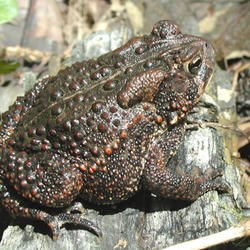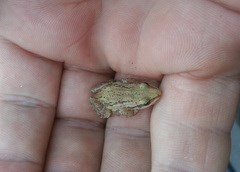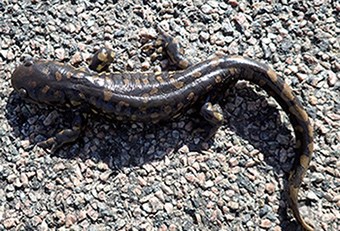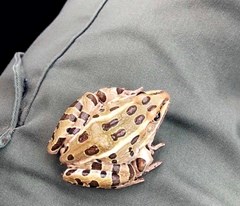Pipestone National Monument has a variety of ecosystems and is generally wet during the springtime. These conditions allow for the presence of several species of amphibians. The temporary pools created by the quartzite outcroppings as well as several small, fleeting wetlands provide suitable habitat for the following species at the Monument:
USGS/Public Domain Size: Typically 2" to 4" long and females tend to be larger than males. Appearance: Stout with short legs. They can be tan, brown, olive green, or reddish-brown with warts that are either yellow or red. Sound: The males will attempt to attract females with a high-pitched trill that can last for almost 30 seconds. Diet: They thrive on insects and one toad can eat up to 1,000 insects a day. However, while they eat with their mouth, they actually drink through their skin. Their lower abdomen has something called a 'seat patch' that they use to absorb water. Do they cause warts? Contrary to popular belief, touching a toad does not cause warts. However, they do secrete a toxin that protects them from predators. So if you touch a toad, don't touch your face and be sure to wash your hands as soon as you're able to do so. 
NPS/Seth Hendriks Size: They average around 1.5" long, with females tending to be larger than males Appearance: Colors can vary, including olive green, brown, tan, or brown. They typically have 3 stripes down their back (sometimes patterned in dots) and a dark stripe on both sides of their body (starting at the nose and going back over the eyes). Sound: The sound they make has been compared to running your thumbnail over a fine-toothed comb. Don't be fooled by their tiny size - their calls can be heard from up to half a mile away! Diet: They eat small insects, such as flies, mosquitoes, spiders, and ants Easy to spot? Not easy at all! They're very tiny, nocturnal, and have secretive habits - all traits that help them survive in a world with much larger predators. 
NPS/Seth Hendriks Size: On averge, 6"-8", but some as large as 14" have been recorded Appearance: Colors vary from black, grey, or green with yellowish blotches or elongated spots. They have thick necks and legs, short snouts, long tails, and large, lidded eyes. Diet: Insects, worms, and smaller amphibians What survival in the wild can look like for a tiger salamander: They spend much of their time - especially in hotter weather - in burrows up to 2' deep and can live in the wild for up to 15 years! 
NPS/Seth Hendriks Size: Approximately 2"-5" long, with females tending to be larger than males Appearance: They are usually green or brown with circular, dark spots bordered by lighter colored rings. A pair of pinkish/white ridges run parallel from behind their eyes and down their back. Sound: A guttural, snoring noise followed by grunts Diet: Insects, worms, smaller amphibians (including other frogs), and at times even birds and garter snakes How do they avoid predators? Athleticism! These frogs are excellent swimmers and when on land, can jump 5-6 feet in a zig-zag pattern to evade capture. |
Last updated: April 25, 2019
